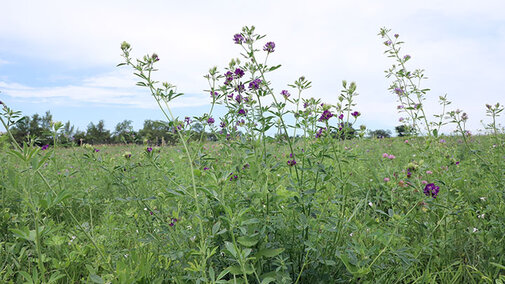Dormant Spraying Alfalfa Weeds
By Todd Whitney
As our weather warms, alfalfa producers are reminded to eliminate weeds in their fields before plants break dormancy. Herbicides for controlling winter annual weeds such as pennycress, mustards and shepherd's purse should be applied before alfalfa regrowth reaches 2 inches of height. If alfalfa shoots are green when sprayed, its growth may be set back a couple weeks.
Broadleaf weeds can lower yields, reduce hay quality and slow first-cutting alfalfa dry-down. Grassy weeds such as downy brome, cheatgrass and bromegrass can have even higher impact on lowering hay quality.
If your alfalfa variety is Roundup Ready, then glyphosate can be applied to the alfalfa almost any time without harming the fields. Fortunately, if you treat your alfalfa soon, you can have cleaner, healthier alfalfa at first cutting.
Before spraying these weeds, be sure they are causing economic damage to your crop. Spraying will provide a purer alfalfa stand but may reduce your overall total tonnage.
Our new Nebraska Extension Weed Guide, EC 130, lists herbicides labelled to control weeds in alfalfa. To be most successful, apply herbicides before alfalfa shoots green up this spring to avoid alfalfa injury. If it does get late, use either Raptor or Pursuit, because they tend to cause less injury to your alfalfa.
Get ready to control unwanted weeds now before alfalfa plants break dormancy. Spray timing is critical.
Replacing Thin Alfalfa
By Ben Beckman
Planting new fields of alfalfa is expensive. So many of us put off tearing up old fields and planting new ones. But is this smart?
Alfalfa stands usually reach peak production by year two or three. After this, yields tend to decline each year. By year four or five, yields are often much lower than their peak years, especially for dryland fields, because the subsurface moisture that plants were using during the early years is all gone. This is most noticeable during drought years when regrowth is almost zero after the first or second cut. Yield decline in irrigated fields is slower but usually is a ton or more lower by year five or six. In addition, thin stands with densities of less than 50 stems per square foot can open the door for weed encroachment.
So, should you try to squeeze another year out of your alfalfa stand? Calculate the costs. First, and most obvious, how will the lower yield of your old field compare to yields from a younger field? A second loss is the lost rotation benefit received by crops like corn that follow alfalfa in the rotation. Not only will alfalfa reduce your nitrogen fertilizer needs by 100-150 pounds over the next couple years, much research has shown that corn after alfalfa often yields 10-20 bushels more per acre than it will even with extra fertilizer.
This rotation benefit could be especially valuable this year if corn prices stay high. So if you have alfalfa fields that are past their prime, or maybe show winter damage this spring, this might be an excellent time to rotate those fields to a different crop and plant some new, higher yielding acres to alfalfa.
Both your alfalfa crop and the rotated crop could benefit.

